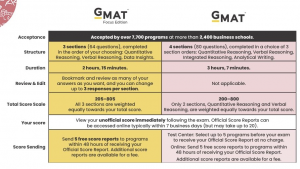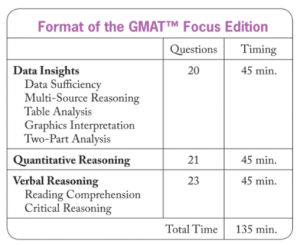- What is GMAT Focus Edition?
- Why is GMAC creating a new version of the GMAT?
- When will GMAT Focus launch?
- When will the Classic GMAT be retired?
- Will my “old” GMAT scores still be accepted by business schools in 2024 (or later)?
- GMAT Focus vs Old GMAT - What are the Key Differences?
- GMAT Focus Exam Content: What is tested?
- Is the GMAT score scale changing? Is GMAT Focus still adaptive?
- How can I prepare for the GMAT Focus?
1. What is GMAT Focus Edition?
The GMAT Focus, an updated and next-generation version of the classic GMAT exam, was launched by GMAC on November 7, 2023. The new GMAT format is tailored to meet the evolving demands of business education and digital proficiency. Serving as the primary exam for MBA and graduate management program admissions, the new GMAT signifies a key evolution in the GMAT's format. The classic GMAT version will be officially retired on January 31, 2024.
Key Features of the New Test:
- Exam Structure:
- Three Distinct Sections: Quantitative Reasoning, Verbal Reasoning, and Data Insights (NEW!)
- Flexibility to take the exam sections in any order for optimal performance – NEW!
- Single Break Option: Granted after either the first or second section of the exam – NEW!
- Ability to bookmark questions for review and change up to three answers per section – NEW!
- Scoring and Reporting:
- Revised Scoring Scale: The new GMAT features a total score range of 205 to 805 in 10-point increments, encompassing Quantitative, Verbal, and Data Insights sections – NEW!
- Individual Section Scores: Candidates will receive individual section scores on a scale of 60 to 90 in 1-point increments – NEW!
- Option to send your score after you know how you performed, not before – NEW!
- An improved Official Score Report with detailed performance insights, included FREE with registration – NEW!
- Content of the Exam:
- No Sentence Correction in the Verbal Reasoning section – NEW!
- No Geometry questions in the Quantitative Reasoning and Data Insights sections – NEW!
- Data Insights Section Added: This new section, replacing the Integrated Reasoning section, combines Data Sufficiency and Integrated Reasoning question styles, contributing directly to the overall GMAT score – NEW!
- Analytical Writing Assessment (AWA) Removed: The AWA section is eliminated, streamlining the focus on quantitative and verbal skills – NEW!
2. Why is GMAC creating a new version of the GMAT?
The changes in the test represent GMAC's response to evolving business education needs. It's designed to better assess skills relevant in today's digital and data-driven age, making the new GMAT more efficient and accessible for a diverse range of candidates.
3. When will GMAT Focus launch?
The new GMAT Exam was launched on November 7th, 2023. The registration is now open!
Aspirants can check the official GMAT website and local test centers for availability in their region.
4. When will the "old" GMAT Exam be retired?
The classic version of the GMAT will be officially retired on January 31, 2024, making way for the exclusive use of the new GMAT thereafter.
5. Will my “old” GMAT scores still be accepted by business schools in 2024 (or later)?
With the introduction of this iteration of test, many applicants are concerned about the validity and acceptance of scores from the classic GMAT version. GMAT Club's analysis indicates that GMAT Classic scores should remain acceptable for the following 5 years.
Validity of Classic GMAT Scores
The Graduate Management Admission Council (GMAC), the official source of GMAT, has assured that scores from the classic GMAT will retain their validity. Business schools typically accept GMAT scores that are up to five years old. Therefore, scores obtained from the current GMAT, before its retirement, will continue to be valid and accepted by business schools for 5 years post-2024.
Business Schools' Perspective
Business schools are preparing for the GMAT format change, understanding the transition from the classic GMAT to the GMAT new exam. They are expected to accept both versions of the scores during this transition. Given the history of accepting GMAT available scores for over 25 years, these reliable and well-known scores will continue to be recognized because MBA programs are interested in getting as many applicants as they can (one reason for test-optional policy for example), so if Schools are taking people without scores, they will definitely take people with Classic GMAT scores. If you have a 750, don't bother retaking the Focus.
Planning for Admissions
For those embarking on their test prep journey, it's crucial to consider the differences between the classic GMAT and the new GMAT. GMAC offers official practice questions and official practice exams to help candidates evaluate which exam should they take. The GMAT Focus official prep and the official practice tests provide insights into the real exam environment. Furthermore, if you are choosing between two tests, consider the percentiles for each of the tests. GMAC has published GMAT to GMAT Focus conversion tables for easy cross-reference.
6. GMAT Focus vs Old GMAT - What are the Key Differences?
The changes in the GMAT test are significant with the introduction of the new GMAT, which features innovative updates compared to the classic GMAT:
7. GMAT Focus Exam Content: What is tested?
The new GMAT, while streamlined, continues to comprehensively test the skills and knowledge essential for success in business school. Here’s a breakdown of what is tested in each of the three sections of the new exam.
Quantitative Reasoning
This section, lasting 45 minutes and consisting entirely of 21 Problem Solving questions, evaluates problem-solving skills in various areas, including arithmetic, algebra, word problems, probability, and more. It focuses on assessing the ability to analyze and solve a range of quantitative problems. This section no longer contains Data Sufficiency questions, which were moved to Data Insights section.
Verbal Reasoning
In the Verbal Reasoning section, test-takers are given 45 minutes to answer 23 questions, which are exclusively Reading Comprehension and Critical Reasoning questions. This section evaluates the ability to understand and analyze written material and arguments. As mentioned before, Sentence Correction has been removed from the new GMAT entirely.
In the verbal section, based on the several practice tests I've taken, I consistently encountered exactly 4 Reading Comprehension (RC) passages, each accompanied by either 3 or 4 questions. The distribution between Reading Comprehension and Critical Reasoning questions was:
- Either 13 RC and 10 CR questions, or 14 RC and 9 CR questions.
This meant I either faced 3 RC passages with 3 questions each and 1 RC passage with 4 questions, or 2 RC passages with 3 questions each and 2 RC passages with 4 questions.
Data Insights
The new Data Insights section is a 45-minute section with 20 questions. It tests a candidate’s ability to analyze and interpret data, integrating skills in math, data analysis, and verbal reasoning. This section assesses the ability to apply data to real-world business scenarios, a critical skill in today's data-driven business environment. It consists of Data Sufficiency, Multi-Source Reasoning, Graphs and Tables, and Two-Part Analysis questions.
- Data Sufficiency: This question type, formerly part of the Quantitative section, assesses your ability to analyze quantitative problems, identify relevant data, and determine when there is sufficient information to solve a problem. It has been moved to the Data Insights section from the Quantitative section. Consequently, the Quantitative section now consists exclusively of Problem Solving questions.
- Multi-Source Reasoning: Involves examining and analyzing data from various sources, such as text, tables, and graphics. It requires recognizing discrepancies among data sources and drawing relevant inferences.
- Table Analysis: Focuses on your ability to sort and analyze data in a table format to identify relevant information or meet specific conditions.
- Graphics Interpretation: Tests your skill in interpreting information from graphical images, like graphs and charts, to discern relationships and make inferences.
- Two-Part Analysis: Challenges you to solve complex problems that may be quantitative, verbal, or both. This versatile format assesses your ability to evaluate trade-offs, solve equations, and understand relationships between entities.
From the several practice tests I've taken, the average distribution of question types in the Data Insights section typically looks like this:
- Data Sufficiency: 6 questions (from 5 to 7)
- Graphs and Tables: 5 questions (from 5 to 6)
- Two-part Analysis: 5 questions (from 5 to 6)
- Multi-source Reasoning: 4 questions (from 4 to 5, once 6)
Additionally, out of these, there are approximately 7 Non-Math Related questions (from 5 to 8) per DI section. None of the Non-Math Related questions were from Data Sufficiency.
Overall Focus of the Exam
The GMAT's new exam represents a significant GMAT format change. It emphasizes key skills like quantitative analysis and verbal reasoning. The changes in GMAT reflect evolving business education needs. This new GMAT exam aligns closely with the skills required in today's business world.
8. Is the GMAT score scale changing? Is GMAT Focus still adaptive?
The scoring system and the adaptive nature of the new exam are crucial aspects for test-takers to understand as they prepare for the exam.
Scoring Scale for GMAT Focus
The new test features a different scoring scale compared to the classic GMAT. In this new version, the total score, ranging from 205 to 805 in 10-point increments, includes performance across all three sections: Quantitative, Verbal, and Data Insights. Unlike the old GMAT, where only the Quantitative and Verbal sections contributed to the total score, the new GMAT integrates all three sections into the overall score. Additionally, candidates will receive individual section scores on a scale of 60 to 90 in 1-point increments.
Percentiles in GMAT Focus
Percentiles are an important aspect of understanding how a test-taker's score compares with other examinees. The new test will have its own percentile rankings for each section and the overall score. Detailed percentile tables can be checked at the following link: GMAT Focus to GMAT Classic Percentiles Score Calculator Conversion.
Adaptive Nature of the Exam
The new exam continues the adaptive testing approach, where the difficulty of questions adjusts based on the test-taker's performance. Thus, the GMAT Focus remains a question-adaptive exam, similar to the classic GMAT version. This feature ensures that the exam remains a precise and personalized measure of a candidate’s abilities.
Improved Score Report at No Extra Cost
The new edition of the test now includes an improved official score report, similar to the Enhanced Score Report (ESR), but at no additional cost. This new feature replaces the previous requirement of purchasing an ESR for $30 to gain detailed performance insights. The report offers a thorough analysis of a candidate's strengths and areas for improvement, with breakdowns by section and question type, aiding significantly in evaluating and enhancing their test preparation and strategy.
9. How can I prepare for the GMAT Focus?
Effective preparation for the changed test can be enhanced by utilizing the following comprehensive resources:
-
- GMAT Focus Edition - Everything You Need to Know: In-depth understanding of the new exam format and features.
- GMAT Classic vs. New GMAT Focus - Which Test to Take?: Insights into deciding between the Old GMAT and the New GMAT.
- GMAT Club YouTube channel: Comprehensive video tutorials and tips.
- Forums for questions and discussions:
- GMAT Club Tests: Practice tests for thorough preparation.
- GMAT Club Quiz: Quizzes for various sections of the GMAT.
- GMAT Club Error Log: Tool to track and analyze your preparation progress.





